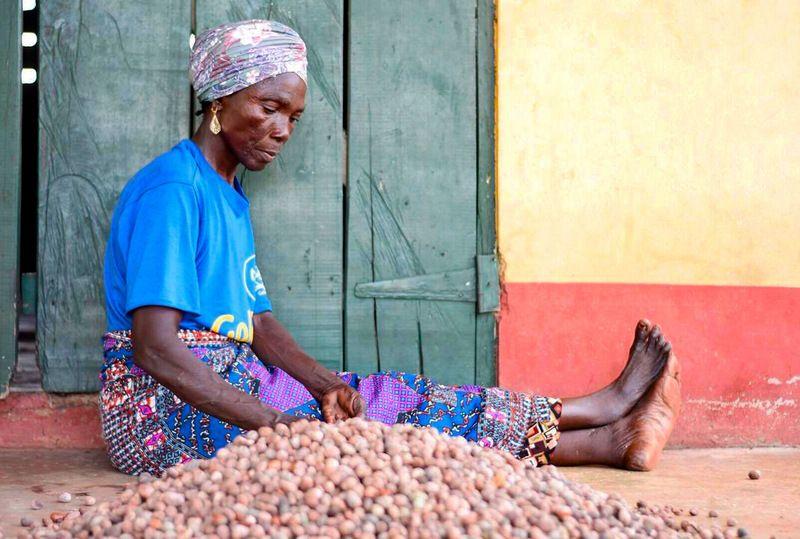Africa-Press – Uganda. By Zubaida Ismail, bird
It is 10am in the Sagnarigu Municipality of northern Ghana.
In a gated compound, around twenty of the thirty women who work here have arrived and are seated beneath the branches of a neem tree and in the shade of a nearby shed, casually talking. The hot topic today is the recent return of sourcing companies – which will translate into more work for the team. That is a good thing. The more these women can sell, the more money they will make.
In the background sit at least five ovens – part of the equipment developed to make shea nut processing possible here at the Pagsung Shea Nut Processing Centre.
The initiative was started by Ghanaians Adisa Lansah and Sanatu Andani with funding from the Danish International Development Agency (DANIDA) as well as support from the United Nations Population Fund and the Japan Embassy in Ghana.
The team is made up of women on different ends of the shea production spectrum, from those vested in the shea trade to beginners who have simply resolved to try something new.
Shea nuts are a cash crop obtained from the African shea tree (Vitellaria paradox), found in the savannah regions of Ghana. Oil extract, or “butter” extracted from the nuts is used in the production of beauty and food products.
90% of today’s shea demand comes from the confectionery industry as it affords chocolate manufacturers an alternative to cocoa butter. Shea is also highly sought after in the realm of cosmetics, which serves as an important source of diversification of demand.
Around 90,000 women in northern Ghana derive their source of livelihood from the shea value chain, according to a report by the Inclusive Business Action Network.
The nuts, harvested from the trees unique to sub-Saharan Africa, are in high demand from several world markets. In fact, of the estimated 600,000 tons of shea nuts harvested in West Africa, some 350,000 tons are exported, mostly as raw nuts. The remaining 250,000 tons are processed and consumed locally, leaving plenty of opportunity for local beneficiation.
That is where the Pagsung Shea Nut Process Facility comes in.
Traditionally, shea harvesting has been an important source of income for women in the north of Ghana.
“While women in the northern regions of the country are by tradition excluded from land access, they have been allowed ownership of shea nuts, which they can freely pick in the wild, and the butter produced from it – potentially a large source of income given that more than 60% of available shea nuts in the Northern region of Ghana are left in the bush uncollected,” the report states.
However, simply reaping the nuts meant that women were not included in the downstream value chain created from their labour.
The Pagsung Shea Nut Processing centre changes that. Women, mainly in their early forties and fifties, can be found processing, packaging and selling processed shea butter, the product of their labour, here at the centre The women work in three groups of thirty, each with a single leader lending support to each member who has an order to process.
Together, the women process at least five, fifty-kilogram sacks of shea nuts into oil each day for clients who export the product far beyond the shores of Ghana.
The skills required during the process include manually sorting through the nuts – sifting bad ones from good, washing the selected nuts, drying, roasting, milling, boiling and, finally, filtering the oil to ensure it is clean and ready for purchase.
Among the women in the centre is Abiba Zakaria, who is in her late fifties. She joined the group after her husband died, some four years ago.
“I started processing shea back in my first matrimonial home. I used to wake up as early as 5:00 am to go pick nuts in the wild,” she explained.
After initially doing the harvesting herself, she quickly realised that she could make more money buying nuts from other harvesters and processing those, rather than processing only what she could harvest. After raising some cash, she made the leap, saving her the trouble of having to get the nuts in the bush – often at the risk of snakebite or scorpion sting.
However, Zakaria’s home-based processing facilities left much to be desired.
“I used to manually and single-handedly process the nuts with firewood. I used to sell the butter in small bowls and calabashes. But I challenged myself when this centre was opened to try processing for clients as an addition to my personal production and I must say, it’s been awesome.” Abiba remarked.
“Now I am able to buy three bags of shea nuts at a cost of 600 cedis (100 US dollars) and I do this at least every two weeks”.
Not only has she found solace at the centre, but she has also expanded her knowledge on her trade, especially with regard to hygiene practices.
“I didn’t know that one needed to clean nuts after purchasing, before processing but this is one of the knowledges I have learnt working here,” an empowered Abiba told bird.
“I have learnt that you have to select bad nuts from good nuts first when you purchase them from the market. Then select unwanted particles and then wash. I have also learnt to allow the oil to settle at least overnight then sieve it, then package it. I had no idea of all this before I joined the centre,” she explained.
She also revealed that before joining the centre, she had never weighed her processed shea butter before trading it – which resulted in her earning little over the equivalent of 3 US dollars for a long day of toil.
“I now know that I have to weigh the end product before sale. I didn’t know what a kilogram was and felt cheated after I discovered that I have for all these years short-changed myself,”
Abiba’s earnings have since shot up from the equivalent of 3 US dollars to almost 20 dollars per day, over the last four years and with that, she has put her children through school. She also hopes to construct a moderate apartment from the savings from her trade.
The Pagsung facility also has also come a long way. Initially, the women at the centre would process the shea nuts under trees, earning very little but the introduction of equipment and better structures has facilitated a more efficient and valuable way of processing shea – and drawn in more capital.
On a global scale, the market dynamics for vegetable fats are complex and are generally dominated by commodities traders. The shea market on the other hand is highly artisanal and fragmented. This presents an ongoing challenge to the appropriate value assignment to shea and its supply network relative to other fats (palm oil and cocoa butter in particular).
Research by the USAID in March 2010 revealed the shea industry is subject to structural issues – reliable electric power, transport and access to financing.
“The path to development for shea lies in the investment of processing equipment, skills training, and, most important, organizational restructuring of the supply chain”, the research recommended. Pagsung is one small step along that chain.






